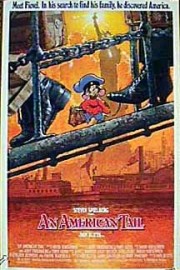An American Tail
Two of my early favorite animated films were not by Disney, but by independent animator Don Bluth. Both featured the standard songs that help move the story along, as well as talking animals that were just as likely to be funny as well as serious. One was “The Secret of NIMH.” The other was “An American Tail.”
At the time, Disney was in it’s dark period, although by 1989 they would be back on top with “The Little Mermaid.” But Bluth kept working, with films like “All Dogs Go to Heaven” and “The Land Before Time.” Unfortunately, since his relatively mediocre films produced for Fox in 1997 (“Anastasia”) and 2000 (“Titan A.E.”), Bluth has been dormant. Of course, it doesn’t help that traditional animation has been on its’ way out the past decade. Hopefully, Disney’s “The Princess and the Frog” will restore traditional animation to prominence, and we might get a new Bluth film.
One thing Bluth accomplished with both “NIMH” and “An American Tail”- the latter of which was produced by Steven Spielberg- was an ability to tell a dark, dramatic story in a way that’s entertaining without being off-putting to adults and children alike. It’s part of the reason Pixar has been able to push the boundaries the way they have with films like “Up” and “Wall-E.”
“An American Tail” tells the story of the Mousekewitz family, a Russian family who- after a cat attack at the turn of the 19th century- gets on the long boat to America, a place that promises “no cats.” During a storm at sea, however, young Fievel gets separated from his family. Both of them make it to America, but Fievel will have a rough time with finding his family.
How rough? Mob boss Warren T. Rat sells him into slave labor. He’s captured by cats. And he ends up on the streets with other orphaned kids. He comes near death several times. It can be pretty scary, but it works because Bluth and his screenwriters Judy Freudberg, Tony Geiss, and David Kirschner find room for great warmth. Compassion is shown little Fievel by several mice, including Italian mouse Tony, the lovely Bridget, the aristocrat Gussie (Madeline Kahn), and the politician Honest John, a French bird named Henri (Christopher Plummer). Even a misfit cat named Tiger (voiced by the late, peerless Dom DeLuise).
Most importantly, his sister Tanya never gives up hope, leading to the unforgettably moving musical duet “Somewhere Out There.” How this song- by composer James Horner (whose score is one of his best), Barry Mann, and Cynthia Weil- didn’t win the Best Original Song Oscar this year is another Oscar injustice, and admittedly one not altogether unexpected. But it’s a classic that connects both characters, and stands the test of time apart from the film as well.
The film itself stands against that same test. Bluth’s animation is a thing of beauty, with a dark and realistic pallet that emphasizes the film’s emotional highs all the more. It’s like a feature-length version of the “Night on Bald Mountain” section of “Fantasia” at times. Nowadays, you couldn’t get away with the film’s G rating- it can get pretty scary, and the film’s unique perspective on the American immigrant experience is a little too mature now. But the characters are as endearing as ever, the story still funny and touching. It made me want to find “The Secret of NIMH”- Bluth’s other unquestioned classic- and revisit that movie. His later films haven’t found the same lasting impact on viewers, which makes these two films stand out all the more in their emotional and dramatic strength.










